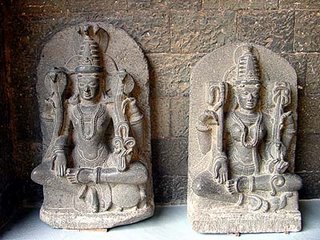I was pretty intrigued by this yaksha in particular - because in typical Hindu sculpture, yaksha men are fat pot-bellied dwarves, and this guy was anything but that!
 A little digging around gave me half the answer - this is a Jain yaksha, not a Hindu one. But the pot-belly still ought to apply - so how did they become so good-looking? I looked it up some more - and found a story.
A little digging around gave me half the answer - this is a Jain yaksha, not a Hindu one. But the pot-belly still ought to apply - so how did they become so good-looking? I looked it up some more - and found a story. The male yaksha's name is Dharanendra, and that is his consort Padmavathi. The couple rose from their sub-terranean world, to protect Parshvanatha, the 23rd Jain Tirthankara (Tirthankara = Enlightened One) from a flood. Dharanendra spread his serpent hood over Parshvanatha, and Padmavathi a diamond umbrella.
In return, they attained godhood and became perfect divine beings (so that explains their good looks!) Dharanendra's vehicle is the popular tortoise (can you see it, just under his knee?), but Padmavathi has a curious vehicle - a rooster with the head of a snake.
Go figure.



